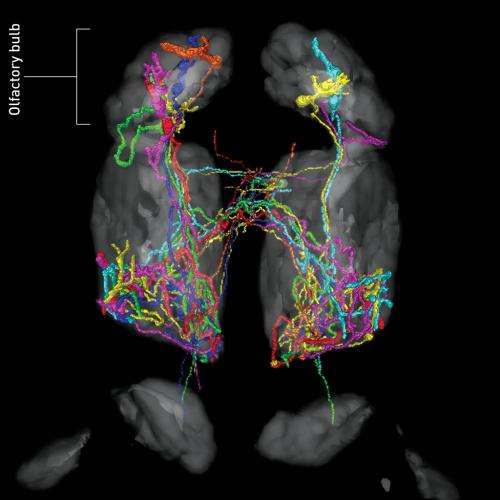Figure 1: A three-dimensional rendering of seven individual output neurons (various colors) projecting from the olfactory bulb to different brain regions on a common reference brain (gray). Credit: N. Miyasaka et al.
The processing of sensory information in the brain involves a complex network of neural connections specific to each type of sensory input. Much is known about the neural wiring associated with most senses, but the deeper wiring of the olfactory system has remained poorly understood. Nobuhiko Miyasaka, Yoshihiro Yoshihara and colleagues from the RIKEN Brain Science Institute, in collaboration with researchers from the Massachusetts Institute of Technology in the United States, have now mapped previously unknown olfactory pathways that help to explain how smell affects behavior1.
Information about smell reaches the brain in two stages. It first passes from the nose to the olfactory bulb—a structure in the brain that is specialized for processing odors. From here, smell information passes to other processing areas of the brain where it is integrated with other information.
"The wiring diagram from the nose to the olfactory bulb has been well studied," explains Miyasaka, "but the projection patterns from the olfactory bulb to higher brain centers have yet to be elucidated in vertebrates, especially at the single-neuron level."
The research team set out to construct a detailed wiring diagram of this second stage of the olfactory system by visualizing neurons that project from the olfactory bulb in zebrafish larvae. Using a technique that allowed single neurons in each animal to be fluorescently labeled, the researchers were able to trace projections of single cells under the microscope and map the connections between individual neurons and other areas of the brain (Fig. 1).
Miyasaka and his colleagues identified five brain regions that receive information from olfactory bulb neurons and showed that individual neurons connect to several of these regions. They also found differences in how the regions receive information; some receive inputs from all areas of the olfactory bulb, others from specific regions. In some regions, inputs from different areas of the olfactory bulb are segregated, and in other regions they are mixed.
"Our findings suggest that higher olfactory centers extract and integrate information differently depending on their functions in odor information processing," says Miyasaka. "Odor information is first represented in the olfactory bulb as an odor map, representing chemical features of odor molecules," he explains. "Higher olfactory centers may read the odor map to create other forms of sensory representations. These could then be further processed, leading to a specific behavioral response."
Miyasaka expects that these insights into odor information processing will assist research on other sensory systems and neural circuits underlying animal behaviors.
More information: Miyasaka, N., Arganda-Carreras, I., Wakisaka, N., Masuda, M., Sümbül, U., Seung, H. S. & Yoshihara, Y. "Olfactory projectome in the zebrafish forebrain revealed by genetic single-neuron labelling." Nature Communications 5, 3639 (2014). DOI: 10.1038/ncomms4639
Journal information: Nature Communications
Provided by RIKEN





















